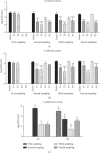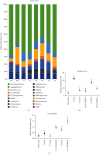Inhibitory Effect of Lactobacillus plantarum CCFM8724 towards Streptococcus mutans- and Candida albicans-Induced Caries in Rats
- PMID: 33414892
- PMCID: PMC7769668
- DOI: 10.1155/2020/4345804
Inhibitory Effect of Lactobacillus plantarum CCFM8724 towards Streptococcus mutans- and Candida albicans-Induced Caries in Rats
Abstract
Streptococcus mutans is a recognized cariogenic bacterium and a major producer of biofilm matrix. The presence of Candida albicans in dental plaque with S. mutans enhances the virulence leading to the onset of rampant caries which is similar to early childhood caries (ECC). The purpose of this study was to explore the effect of Lactobacillus plantarum CCFM8724 (CCFM8724) on the treatment and prevention of dental caries induced by S. mutans and C. albicans in vivo. Rats were divided into 6 groups: the control group and model group, 2 treatment groups, and 2 prevention groups (0.02% chlorhexidine or CCFM8724). The fluctuation of microbial colonization and the change of bacteria flora in rat oral cavity after sowing of L. plantarum CCFM8724 were investigated by colony-forming units (CFU) and microflora analysis. The caries of rats were assessed by microcomputed tomography (micro-CT) and Keyes scoring method. The results showed that L. plantarum CCFM8724 in both the treatment and prevention groups could significantly decrease the population of S. mutans and C. albicans in the rats' oral cavity (p < 0.001), the mineral loss of enamel (p < 0.05), and the scores of caries (p < 0.05). Besides, L. plantarum CCFM8724 exhibited better effects than chlorhexidine. Hence, L. plantarum CCFM8724 was proved to be a potential oral probiotic on caries treatment and prevention in vivo and it may have the prospect of application in dental caries (especially ECC) prevention products.
Copyright © 2020 Qiuxiang Zhang et al.
Conflict of interest statement
The authors declare no conflict of interests.
Figures





Similar articles
-
Effect of L. plantarum on Caries Prevention and the Oral-Gut Microbiome In Vivo.J Dent Res. 2025 Aug;104(9):993-1002. doi: 10.1177/00220345251325807. Epub 2025 Mar 18. J Dent Res. 2025. PMID: 40103015
-
Effect of Probiotic Lactobacillus plantarum on Streptococcus mutans and Candida albicans Clinical Isolates from Children with Early Childhood Caries.Int J Mol Sci. 2023 Feb 3;24(3):2991. doi: 10.3390/ijms24032991. Int J Mol Sci. 2023. PMID: 36769313 Free PMC article.
-
Lactiplantibacillus Plantarum CCFM8724 Reduces the Amounts of Oral Pathogens and Alters the Oral Microbiota in Children With Dental Caries: a Randomized, Double-Blind, Placebo-Controlled Trial.J Am Nutr Assoc. 2023 May-Jun;42(4):361-370. doi: 10.1080/07315724.2022.2043200. Epub 2022 Mar 21. J Am Nutr Assoc. 2023. PMID: 35512770 Clinical Trial.
-
Roles of Streptococcus mutans-Candida albicans interaction in early childhood caries: a literature review.Front Cell Infect Microbiol. 2023 May 16;13:1151532. doi: 10.3389/fcimb.2023.1151532. eCollection 2023. Front Cell Infect Microbiol. 2023. PMID: 37260705 Free PMC article. Review.
-
Is the oral fungal pathogen Candida albicans a cariogen?Oral Dis. 2018 May;24(4):518-526. doi: 10.1111/odi.12691. Epub 2017 Jun 13. Oral Dis. 2018. PMID: 28513096 Review.
Cited by
-
Inhibitory and preventive effects of Arnebia euchroma (Royle) Johnst. root extract on Streptococcus mutans and dental caries in rats.BDJ Open. 2024 Mar 2;10(1):15. doi: 10.1038/s41405-024-00196-6. BDJ Open. 2024. PMID: 38431610 Free PMC article.
-
Anti-cariogenic Properties of Lactobacillus plantarum in the Utilization of Galacto-Oligosaccharide.Nutrients. 2023 Apr 22;15(9):2017. doi: 10.3390/nu15092017. Nutrients. 2023. PMID: 37432150 Free PMC article.
-
Lactobacillus plantarum Disrupts S. mutans-C. albicans Cross-Kingdom Biofilms.Front Cell Infect Microbiol. 2022 Mar 22;12:872012. doi: 10.3389/fcimb.2022.872012. eCollection 2022. Front Cell Infect Microbiol. 2022. PMID: 35392605 Free PMC article.
-
Differential alteration in Lactiplantibacillus plantarum subsp. plantarum quorum-sensing systems and reduced Candida albicans yeast survival and virulence gene expression in dual-species interaction.Microbiol Spectr. 2024 Jun 4;12(6):e0035324. doi: 10.1128/spectrum.00353-24. Epub 2024 May 8. Microbiol Spectr. 2024. PMID: 38717160 Free PMC article.
-
Unveiling the dual nature of Lactobacillus: from cariogenic threat to probiotic protector-a critical review with bibliometric analysis.Front Oral Health. 2025 Jan 31;6:1535233. doi: 10.3389/froh.2025.1535233. eCollection 2025. Front Oral Health. 2025. PMID: 39959355 Free PMC article.
References
-
- Klein M. I., Falsetta M. L., Xiao J., Bowen W. H., Koo H. The Role of Extracellular Polysaccharides Matrix in Virulent Oral Biofilms. Norfolk, UK: Caister Academic Press; 2013.
MeSH terms
Substances
LinkOut - more resources
Full Text Sources
Medical
Molecular Biology Databases

